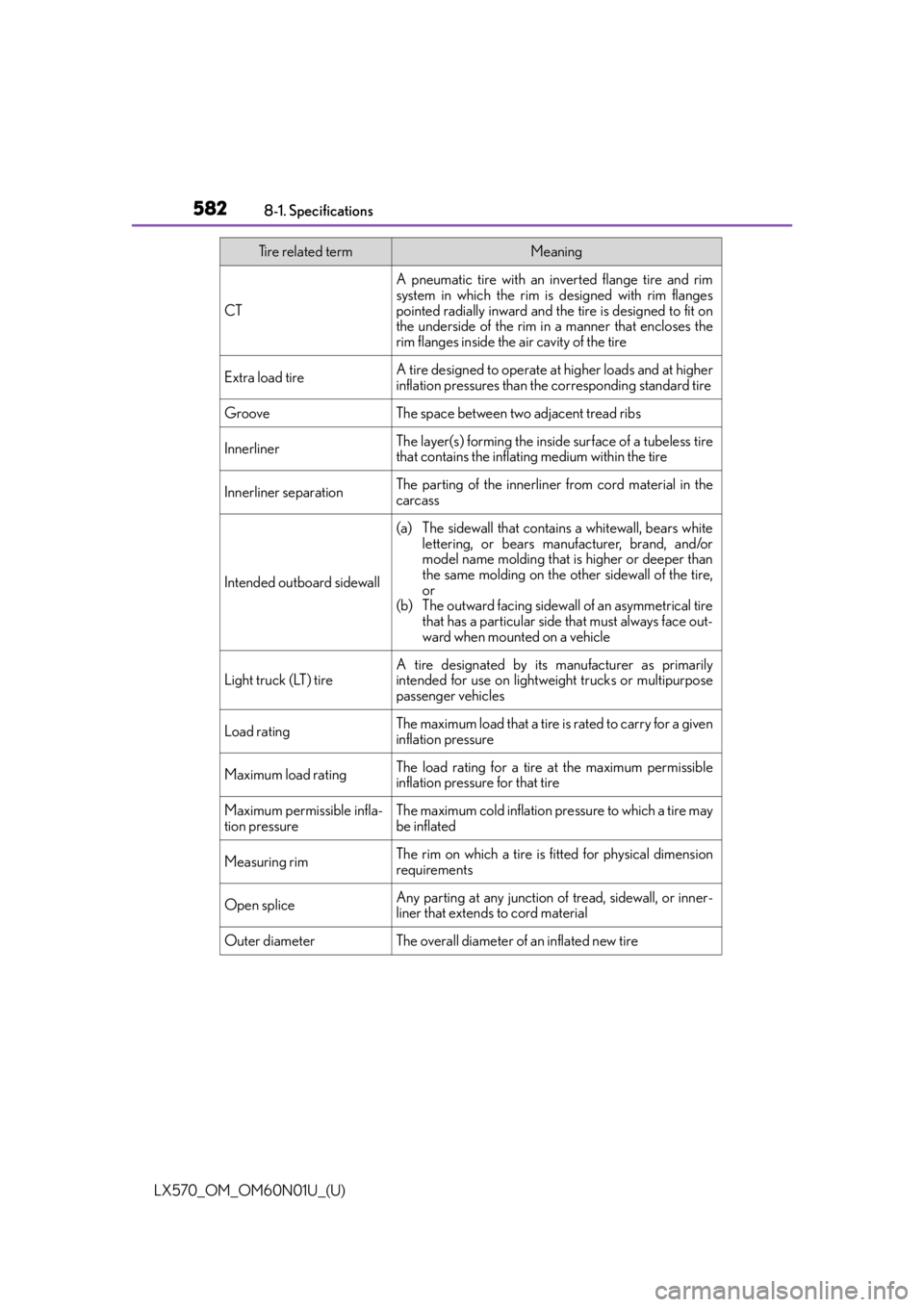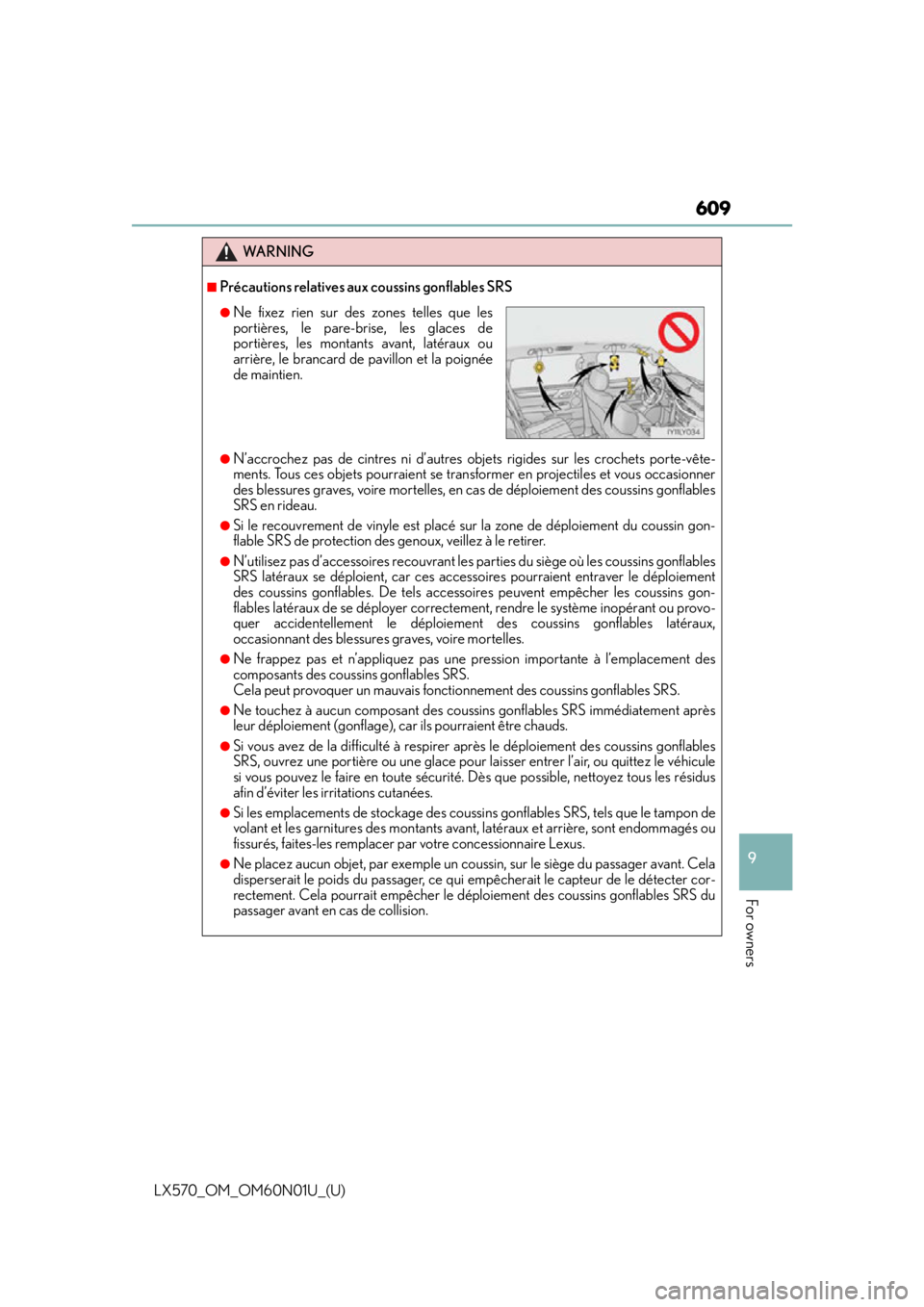ESP LEXUS LX570 2016 Workshop Manual
[x] Cancel search | Manufacturer: LEXUS, Model Year: 2016, Model line: LX570, Model: LEXUS LX570 2016Pages: 632, PDF Size: 8.94 MB
Page 535 of 632

5357-2. Steps to take in an emergency
LX570_OM_OM60N01U_(U)
7
When trouble arises
■If a following message is shown, take appr opriate action and confirm that the message
has disappeared. ( P. 3 0 9 )
●“Crawl Not Available Select L4 an d Shift to [D] or [R] Position”
●“Crawl Not Available Check System Operation Conditions”
●“Turn Assist Function Not Available Check System Operation Conditions”
●“Turn Assist Function Not Available Activate Crawl Control”
■If “Maintenance Required Soon” is shown (U.S.A. only)
Indicates that all maintenance according to the driven distance on the maintenance
schedule
* should be performed soon.
Comes on approximately 4500 miles (7200 k m) after the message has been reset.
If necessary, perform maintenance.
*: Refer to the separate “Scheduled Maintenance Guide” or “Owner’s Manual Supple-
ment” for the maintenance interval applicable to your vehicle.
■If “Maintenance Required Visit Your Dealer” is shown (U.S.A. only)
Indicates that all maintenance is required to correspond to the driven distance on the
maintenance schedule
*.
Comes on approximately 5000 miles (8000 k m) after the message has been reset.
(The indicator will not work properly unless the message has been reset.)
Perform the necessary maintenance. Please reset the message after the maintenance is
performed ( P. 4 6 5 )
*: Refer to the separate “Scheduled Maintenance Guide” or “Owner’s Manual Supple-
ment” for the maintenance interval applicable to your vehicle.
■If “Oil Maintenance Required Soon” is shown
Indicates that the engine oil is scheduled to be changed. (The indicator will not work
properly unless the message has been reset.)
Check the engine oil, and change if necessar y. After changing the engine oil, the mes-
sage should be reset. ( P. 4 7 5 )
■If “Oil Maintenance Required Visit Your Dealer” is shown
Indicates that the engine oil should be chan ged. (The indicator will not work properly
unless the message has been reset.)
Check and change the engine oil, and oil filter by your Lexus dealer. After changing the
engine oil, the message should be reset. ( P. 4 7 5 )
■If “Visit Your Dealer” is shown
The system or part shown on the multi-info rmation display is malfunctioning. Have the
vehicle inspected by your Lexus dealer immediately.
■Warning buzzer
In some cases, the buzzer may not be heard due to being in a noisy location or audio
sound.
NOTICE
■While the engine oil level warning is displayed
Continued engine operation with low engine oil will damage the engine.
Page 558 of 632

5587-2. Steps to take in an emergency
LX570_OM_OM60N01U_(U)
WA R N I N G
■When inspecting under the hood of your vehicle
Observe the following precautions.
Failure to do so may result in serious injury such as burns.
●If steam is seen coming from under the hood, do not open the hood until the steam
has subsided. The engine compartment may be very hot.
●Keep hands and clothing (especially a tie, a scarf or a muffler) away from the fans and
belts. Failure to do so may cause the hands or clothing to be caught, resulting in seri-
ous injury.
●Do not loosen the radiator cap or the coolant reservoir cap while the engine and radi-
ator are hot. High temperature steam or coolant could spray out.
NOTICE
■When adding engine coolant
Add coolant slowly after the engine has cooled down sufficiently. Adding cool coolant
to a hot engine too quickly can cause damage to the engine.
■To prevent damage to the cooling system
Observe the following precautions:
●Avoid contaminating the coolant with foreign matter (such as sand or dust etc.).
●Do not use any coolant additives.
Page 579 of 632

LX570_OM_OM60N01U_(U)
5798-1. Specifications
8
Vehicle specifications
■Temperature A, B, C
The temperature grades are A (the highest), B, and C, representing the tire’s
resistance to the generation of heat and its ability to dissipate heat when
tested under controlled conditions on a specified indoor laboratory test
wheel.
Sustained high temperature can cause the material of the tire to degenerate and
reduce tire life, and excessive temperature can lead to sudden tire failure.
Grade C corresponds to a level of perfor mance which all passenger car tires must
meet under the Federal Motor Vehicle Safety Standard No. 109.
Grades B and A represent higher levels of performance on the laboratory test
wheel than the minimum required by law.
Warning: The temperature grades of a tire assume that it is properly inflated and
not overloaded.
Excessive speed, underinflation, or excessiv e loading, either separately or in com-
bination, can cause heat buildup and possible tire failure.
Page 582 of 632

582
LX570_OM_OM60N01U_(U)8-1. Specifications
CT
A pneumatic tire with an inverted flange tire and rim
system in which the rim is designed with rim flanges
pointed radially inward and the tire is designed to fit on
the underside of the rim in a manner that encloses the
rim flanges inside the air cavity of the tire
Extra load tireA tire designed to operate at higher loads and at higher
inflation pressures than the corresponding standard tire
GrooveThe space between two adjacent tread ribs
InnerlinerThe layer(s) forming the inside
surface of a tubeless tire
that contains the inflating medium within the tire
Innerliner separationThe parting of the i nnerliner from cord material in the
carcass
Intended outboard sidewall
(a) The sidewall that contains a whitewall, bears white
lettering, or bears manufacturer, brand, and/or
model name molding that is higher or deeper than
the same molding on the ot her sidewall of the tire,
or
(b) The outward facing sidewall of an asymmetrical tire that has a particular side that must always face out-
ward when mounted on a vehicle
Light truck (LT) tire
A tire designated by its manufacturer as primarily
intended for use on lightweight trucks or multipurpose
passenger vehicles
Load ratingThe maximum load that a tire is rated to carry for a given
inflation pressure
Maximum load ratingThe load rating for a tire at the maximum permissible
inflation pressure for that tire
Maximum permissible infla-
tion pressureThe maximum cold inflation pressure to which a tire may
be inflated
Measuring rimThe rim on which a tire is fitted for physical dimension
requirements
Open spliceAny parting at any junction of tread, sidewall, or inner-
liner that extends to cord material
Outer diameterThe overall diameter of an inflated new tire
Tire related termMeaning
Page 583 of 632

LX570_OM_OM60N01U_(U)
5838-1. Specifications
8
Vehicle specifications
Overall widthThe linear distance between the exteriors of the side-
walls of an inflated tire, including elevations due to label-
ing, decorations, or pr otective bands or ribs
Passenger car tire
A tire intended for use on passenger cars, multipurpose
passenger vehicles, and trucks, that have a gross vehicle
weight rating (GVWR) of 10,000 lb. or less.
PlyA layer of rubber-coated parallel cords
Ply separationA parting of rubber compound between adjacent plies
Pneumatic tire
A mechanical device made of rubber, chemicals, fabric
and steel or other materials, that, when mounted on an
automotive wheel, provides the traction and contains
the gas or fluid that sustains the load
Radial ply tire
A pneumatic tire in which the ply cords that extend to
the beads are laid at substantially 90 degrees to the
centerline of the tread
Reinforced tire A tire designed to operate at higher loads and at higher
inflation pressures than the corresponding standard tire
Section width
The linear distance between the exteriors of the side-
walls of an inflated tire, excluding elevations due to
labeling, decoration, or protective bands
SidewallThat portion of a tire between the tread and bead
Sidewall separationThe parting of the rubber compound from the cord
material in the sidewall
Snow tire
A tire that attains a traction index equal to or greater
than 110, compared to the ASTM E-1136 Standard Ref-
erence Test Tire, when using the snow traction test as
described in ASTM F-1805-00, Standard Test Method
for Single Wheel Driving Tract ion in a Straight Line on
Snow-and Ice-Covered Surfaces, and which is marked
with an Alpine Symbol ( ) on at least one sidewall
Tire related termMeaning
Page 609 of 632

LX570_OM_OM60N01U_(U)
609
9
For owners
WA R N I N G
■Précautions relatives aux coussins gonflables SRS
●N’accrochez pas de cintres ni d’autres objets rigides sur les crochets porte-vête-
ments. Tous ces objets pour raient se transformer en projectiles et vous occasionner
des blessures graves, voire mortelles, en cas de déploiement des coussins gonflables
SRS en rideau.
●Si le recouvrement de vinyle est placé sur la zone de déploiement du coussin gon-
flable SRS de protection des genoux, veillez à le retirer.
●N’utilisez pas d’accessoires recouvrant les pa rties du siège où les coussins gonflables
SRS latéraux se déploient, car ces access oires pourraient entraver le déploiement
des coussins gonflables. De tels accessoires peuvent empêcher les coussins gon-
flables latéraux de se déployer correctement, rendre le système inopérant ou provo-
quer accidentellement le déploiement des coussins gonflables latéraux,
occasionnant des blessures graves, voire mortelles.
●Ne frappez pas et n’appliquez pas une pr ession importante à l’emplacement des
composants des coussins gonflables SRS.
Cela peut provoquer un mauvais foncti onnement des coussins gonflables SRS.
●Ne touchez à aucun composant des coussins gonflables SRS immédiatement après
leur déploiement (gonflage), car ils pourraient être chauds.
●Si vous avez de la difficulté à respirer après le déploiement des coussins gonflables
SRS, ouvrez une portière ou une glace pour laisser entrer l’air, ou quittez le véhicule
si vous pouvez le faire en toute sécurité. Dès que possible, nettoyez tous les résidus
afin d’éviter les irritations cutanées.
●Si les emplacements de stockage des coussi ns gonflables SRS, tels que le tampon de
volant et les garnitures des montants avant, latéraux et arrière, sont endommagés ou
fissurés, faites-les remplacer par votre concessionnaire Lexus.
●Ne placez aucun objet, par exemple un coussin, sur le siège du passager avant. Cela
disperserait le poids du passager, ce qui empêcherait le capteur de le détecter cor-
rectement. Cela pourrait empêcher le déploiement des coussins gonflables SRS du
passager avant en cas de collision.
●Ne fixez rien sur des zones telles que les
portières, le pare-brise, les glaces de
portières, les montants avant, latéraux ou
arrière, le brancard de pavillon et la poignée
de maintien.